The Academic Phrasebank is a
general resource for academic
writers. It makes explicit the more
common phraseological ‘nuts and
bolts’ of academic writing.
Academic
Phrasebank
A compendium of commonly
used phrasal elements in
academic English in PDF format
2016 enhanced edition
Personal Copy
Dr John Morley
�
PDF Download version
©2016 The University of Manchester
1 | P a g e
�
Preface
The Academic Phrasebank is a general resource for academic writers. It aims to provide the
phraseological ‘nuts and bolts’ of academic writing organised according to the main sections of a
research paper or dissertation. Other phrases are listed under the more general communicative
functions of academic writing.
The resource was designed primarily for academic and scientific writers who are non-native speakers
of English. However, native writers may still find much of the material helpful. In fact, recent data
suggest that the majority of users are native speakers of English.
The phrases, and the headings under which they are listed, can be used simply to assist you in
thinking about the content and organisation of your own writing, or the phrases can be incorporated
into your writing where this is appropriate. In most cases, a certain amount of creativity and
adaptation will be necessary when a phrase is used.
The Academic Phrasebank is not discipline specific. Nevertheless, it should be particularly useful for
writers who need to report their empirical studies. The phrases are content neutral and generic in
nature; in using them, therefore, you are not stealing other people's ideas and this does not
constitute plagiarism.
Most of the phrases in this compendium have been organised according to the main sections of a
research report. However, it is an over-simplification to associate the phrases only with the section in
which they have been placed here. In reality, for example, many of phrases used for referring to
other studies may be found throughout a research report.
In the current PDF version, additional material, which is not phraseological, has been incorporated.
These additional sections should be helpful to you as a writer.
2 | P a g e
�
……………………………………………..……..…..................
……………………………………………..………....................
……………………………………………..………….................
……………………………………………..………....................
……………………………………………..………....................
……………………………………………..………....................
……………………………………………..………....................
……………………………………………..………....................
……………………………………………..………....................
……………………………………………..………....................
……………………………………………..………....................
……………………………………..………..………..................
………………………………………..……..………..................
…………………………………………..…..………..................
……………………………………………....………..................
……………………………………………….………..................
……………………………………………..…..……..................
……………………………………………..……..…..................
……………………………………………..………....................
……………………………………..………..………..................
………………………………………..……..………..................
………………………………………………………………………….
…………………………………………..…..………..................
……………………………………………....………..................
……………………………………………….………..................
……………………………………………..…..……..................
……………………………………………..……..…..................
……………………………………………..………....................
4
7
26
38
45
51
58
68
78
82
85
88
92
93
95
99
101
104
106
110
113
116
118
119
120
122
124
125
Contents
About Academic Phrasebank
Major Sections
Introducing work
Referring to literature
Describing methods
Reporting results
Discussing findings
Writing conclusions
General Functions
Being critical
Being cautious
Classifying and listing
Compare and contrast
Defining terms
Describing trends
Describing quantities
Explaining causality
Giving examples as support
Signalling transition
Writing about the past
Writing abstracts
Notes on Academic Writing
Academic style
Style in presentations
Commonly confused words
British and US spelling
Punctuation
Using articles
Sentence structure
Paragraph structure
Helpful tips for writers
3 | P a g e
�
About Academic Phrasebank
Theoretical Influences
The Academic Phrasebank largely draws on an approach to analysing academic texts originally
pioneered by John Swales in the 1980s. Utilising a genre analysis approach to identify rhetorical
patterns in the introductions to research articles, Swales defined a ‘move’ as a section of text that
serves a specific communicative function (Swales, 1981,1990). This unit of rhetorical analysis is used
as one of the main organising sub-categories of the Academic Phrasebank. Swales not only identified
commonly-used moves in article introductions, but he was interested in showing the kind of
language which was used to achieve the communicative purpose of each move. Much of this
language was phraseological in nature.
The resource also draws upon psycholinguistic insights into how language is learnt and produced. It is
now accepted that much of the language we use is phraseological; that it is acquired, stored and
retrieved as pre-formulated constructions (Bolinger, 1976; Pawley and Syder, 1983). These insights
began to be supported empirically as computer technology permitted the identification of recurrent
phraseological patterns in very large corpora of spoken and written English using specialised
software (e.g. Sinclair, 1991). Phrasebank recognises that there is an important phraseological
dimension to academic language and attempts to make examples of this explicit.
Sources of the phrases
The vast majority of phrases in this resource have been taken from authentic academic sources. The
original corpus from which the phrases were ‘harvested’ consisted of 100 postgraduate dissertations
completed at the University of Manchester. However, phrases from academic articles drawn from a
broad spectrum of disciplines have also been, and continue to be, incorporated. In most cases, the
phrases have been simplified and where necessary they have been ‘sifted’ from their particularised
academic content. Where content words have been included for exemplificatory purposes, these are
substitutions of the original words. In selecting a phrase for inclusion into the Academic Phrasebank,
the following questions are asked:
• does it serve a useful communicative purpose in academic text?
• does it contain collocational and/or formulaic elements?
• are the content words (nouns, verbs, adjectives) generic in nature?
• does the combination ‘sound natural' to a native speaker or writer of English?
When is it acceptable to reuse phrases in academic writing?
In a recent study (Davis and Morley, 2015), 45 academics from two British universities were surveyed
to determine whether reusing phrases was a legitimate activity for academic writers, and if so, what
kind of phrases could be reused. From the survey and later from in-depth interviews, the following
characteristics for acceptability emerged. A reused phrase:
should not have a unique or original construction;
should not express a clear point of view of another writer;
•
•
• depending on the phrase, may be up to nine words in length; beyond this 'acceptability'
declines;
• may contain up to four generic content words (nouns, verbs or adjectives which are not
bound to a specific topic).
Some of the entries in the Academic Phrasebank, contain specific content words which have been
included for illustrative purposes. These words should be substituted when the phrases are used. In
the phrases below, for example, the content words in bold should be substituted:
4 | P a g e
�
• X is a major public health problem, and the cause of ...
• X is the leading cause of death in western-industrialised countries.
The many thousands of disciplinary-specific phrases which can be found in academic communication
comprise a separate category of phrases. These tend to be shorter than the generic phrases listed in
Academic Phrasebank, and typically consist of noun phrases or combinations of these. Acceptability
for reusing these is determined by the extent to which they are used and understood by members of
a particular academic community.
Further work
Development of the website content is ongoing. In addition, research is currently being carried out
on the ways in which experienced and less-experienced writers make use of the Academic
Phrasebank. Another project is seeking to find out more about ways in which teachers of English for
academic purposes make use of this resource.
References
• Bolinger, D. (1976) ‘Meaning and memory’. Forum Linguisticum, 1, pp. 1–14.
• Davis, M., and Morley, J. (2015) ‘Phrasal intertextuality: The responses of academics from
different disciplines to students’ re-use of phrases’. Journal Second Language Writing 28 (2)
pp. 20-35.
• Hopkins, A. and Dudley-Evans, A. (1988). ‘A genre-based investigations of the discussions
sections in articles and dissertation’. English for Specific Purposes, 7(2), 113-122.
• Pawley, A. and Syder, F.H. (1983). ‘Two puzzles for linguistic theory: nativelike selection and
nativelike fluency’. In: Richards, J.C. and Schmidt, R.W. (Eds.), Language and Communication,
pp. 191-226. Longman: New York.
• Sinclair, J. (1991) Corpus, concordance, collocation. Oxford: Oxford University Press.
• Swales, J. (1981). Aspects of article introductions (Aston ESP Research Report No. 1).
Birmingham: Language Studies Unit: University of Aston.
• Swales, J. (1990). Genre analysis: English in academic and research settings. Cambridge:
Cambridge University Press.
5 | P a g e
�
Major sections
6 | P a g e
�
Introducing Work
There are many ways to introduce an academic essay or short paper. Most academic writers,
however, appear to do one or more of the following in their introductions:
indicate an issue, problem, or controversy in the field of study
• establish the context, background and/or importance of the topic
•
• define the topic or key terms
•
• provide an overview of the coverage and/or structure of the writing
state the purpose of the essay or piece of writing
In very short assignments, it is not uncommon for a writer to commence simply by stating the
purpose of their writing.
Introductions to research dissertations tend to be relatively short but quite complex in terms of
their functional elements. Some of the more common elements or include:
indicating a problem, controversy or a knowledge gap in the field of study
• establishing the context, background and/or importance of the topic
• giving a brief synopsis of the relevant literature
• highlighting the inadequacy of previous research
•
• establishing the desirability of the research
•
listing the research questions or hypotheses
• providing a synopsis of the research method(s)
• explaining the significance or value of the study
• defining certain key terms
• providing an overview of the dissertation or report structure
• explaining reasons for the writer's personal interest in the topic
Examples of phrases which are commonly employed to realise these functions are listed on the
following pages. Note that there may be a certain amount of overlap between some of the
categories under which the phrases are listed. Also, the order in which the different categories of
phrases are shown reflects a typical order but this is far from fixed or rigid, and not all the elements
are present in all introductions.
A number of analysts have identified common patterns in the introductions of research articles.
One of the best known is the CARS model (create a research space) first described by John Swales
(1990)1. This model, which utilises an ecological metaphor, has, in its simplest form, three elements
or moves:
• Establishing the territory (establishing importance of the topic, reviewing previous work)
•
• Occupying the niche (listing purpose of new research, listing questions, stating value,
Identifying a niche (indicating a gap in knowledge)
indicating structure of writing)
1 Swales, J. (1990) Genre Analysis, Cambridge: Cambridge University Press.
7 | P a g e
�
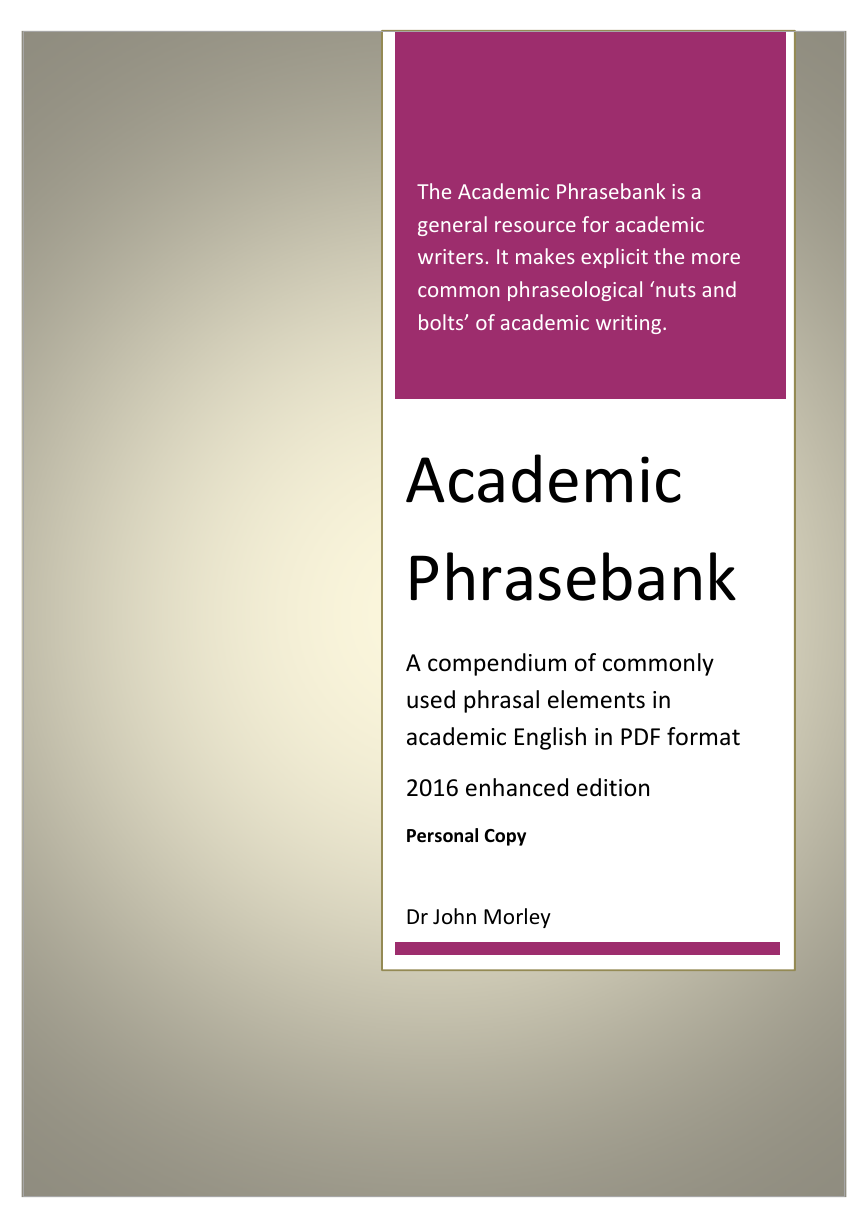
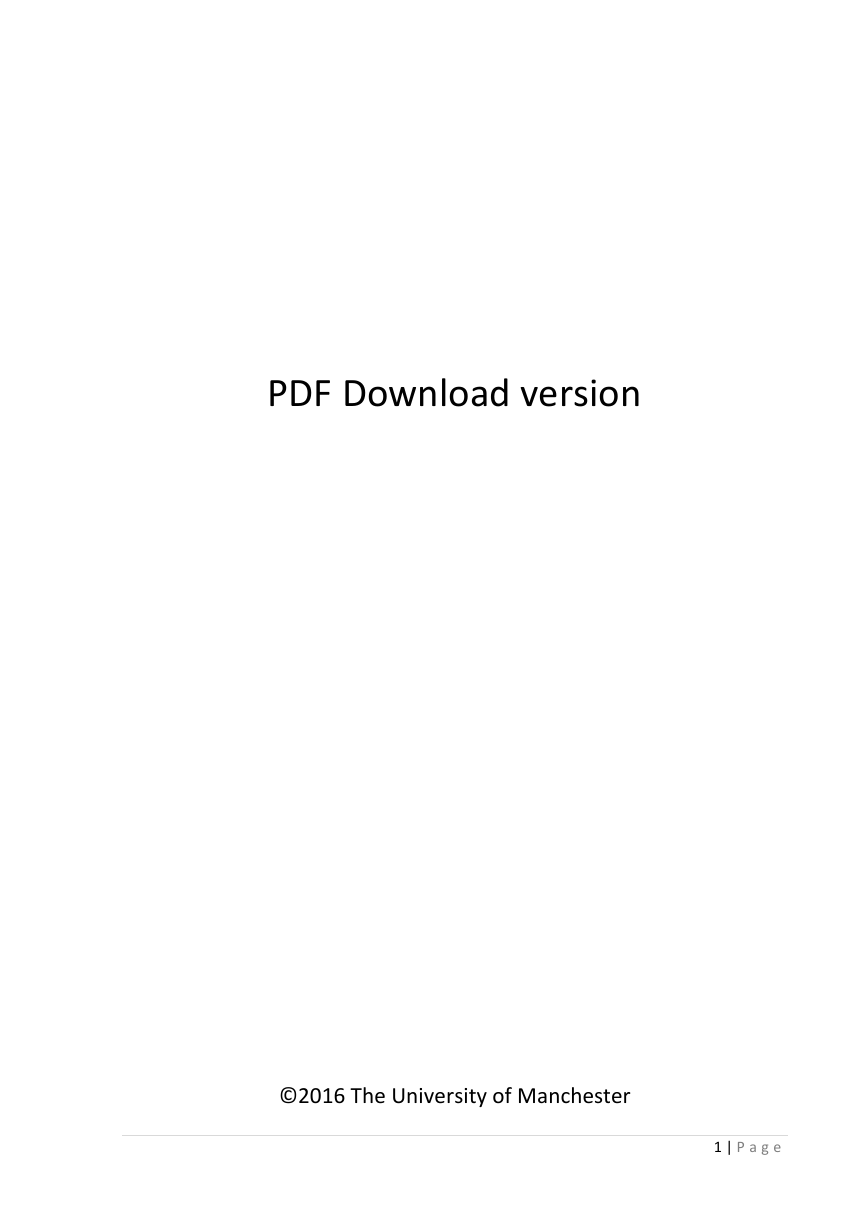
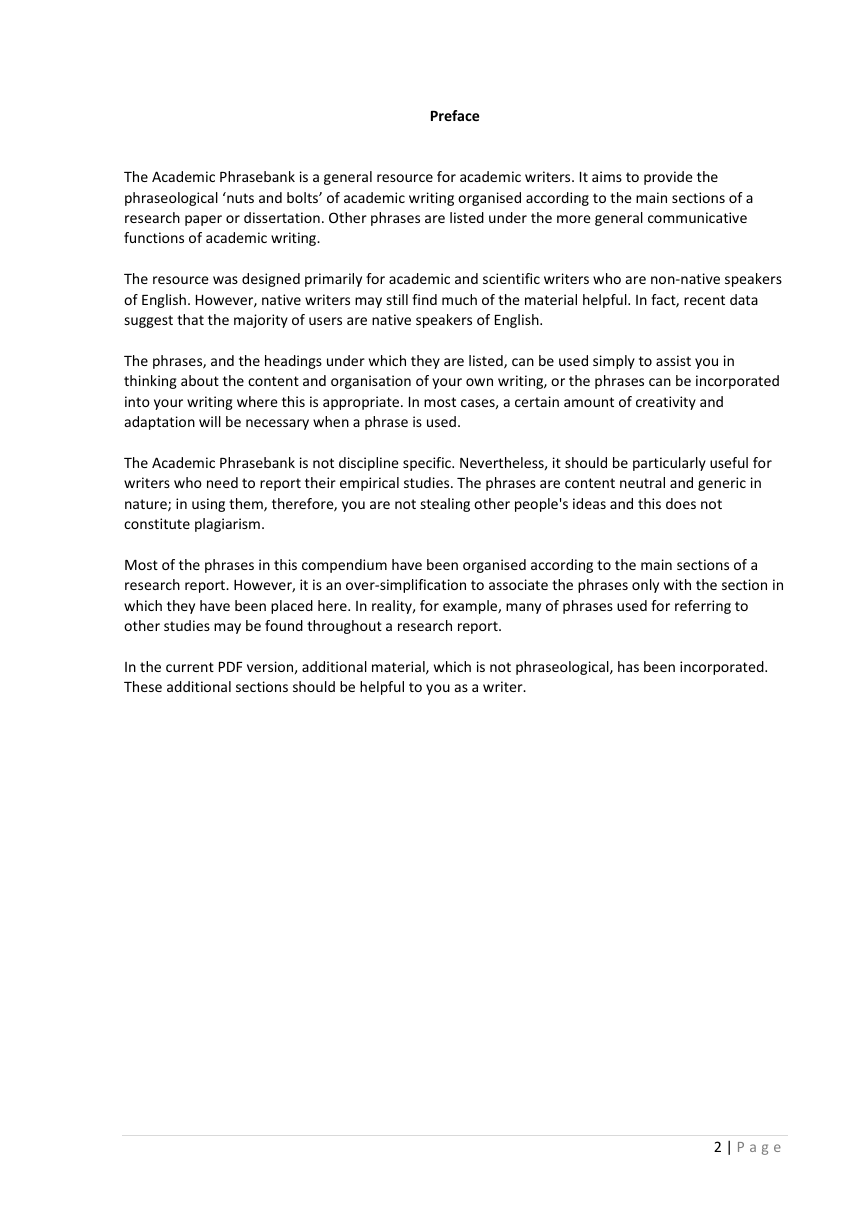
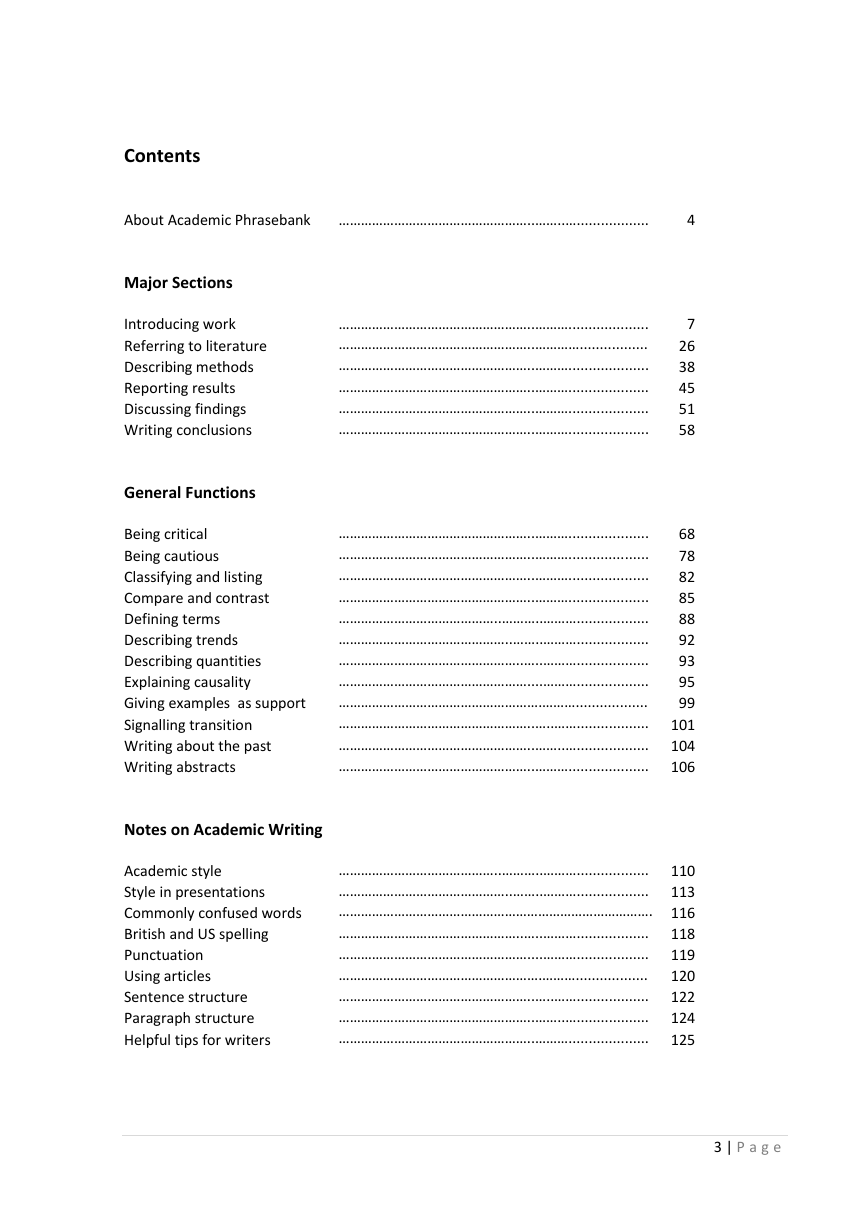

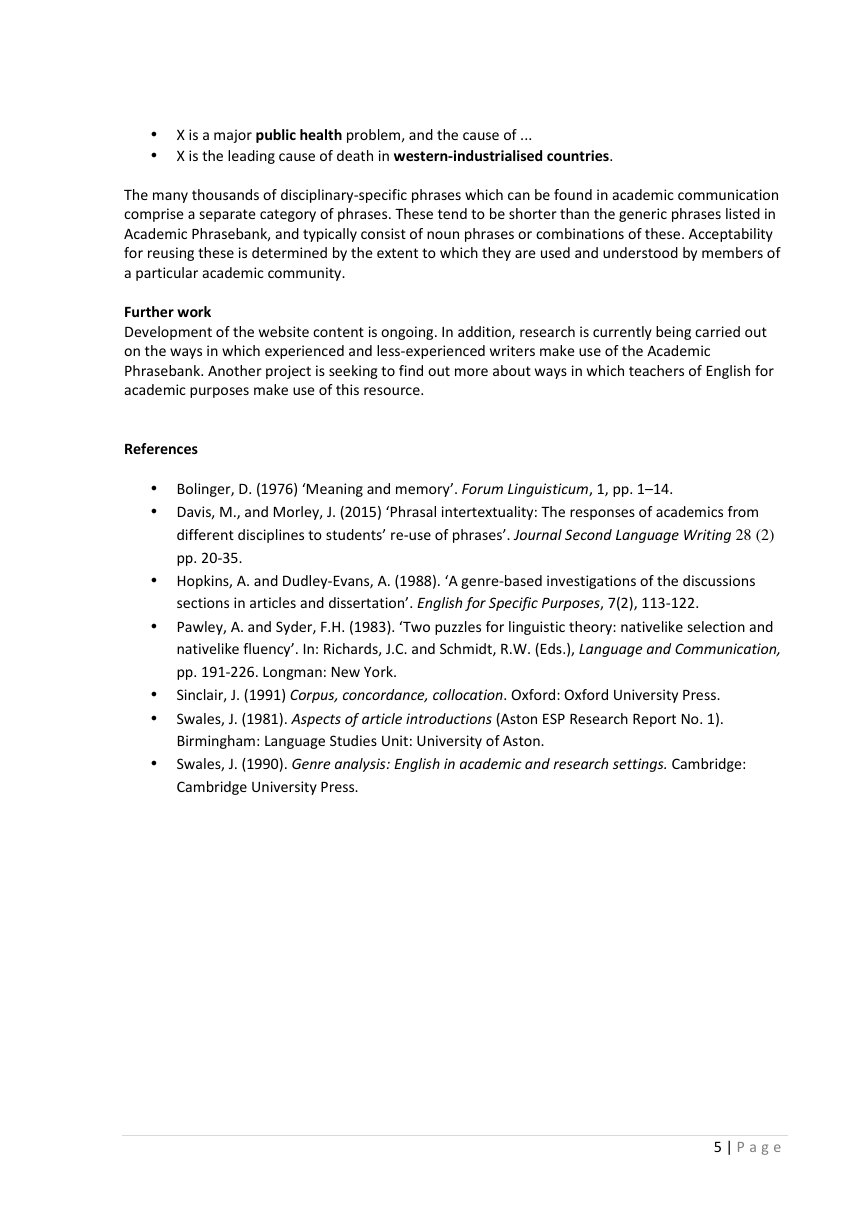
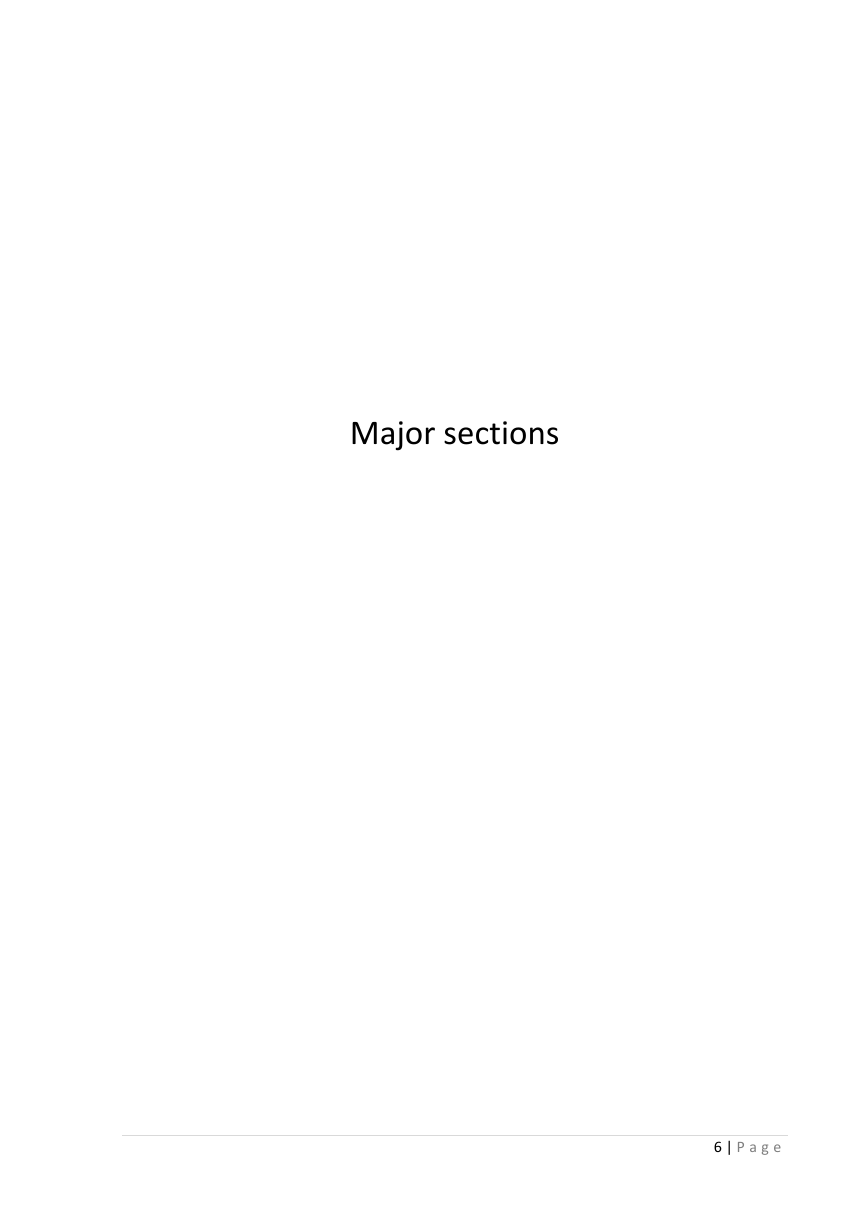
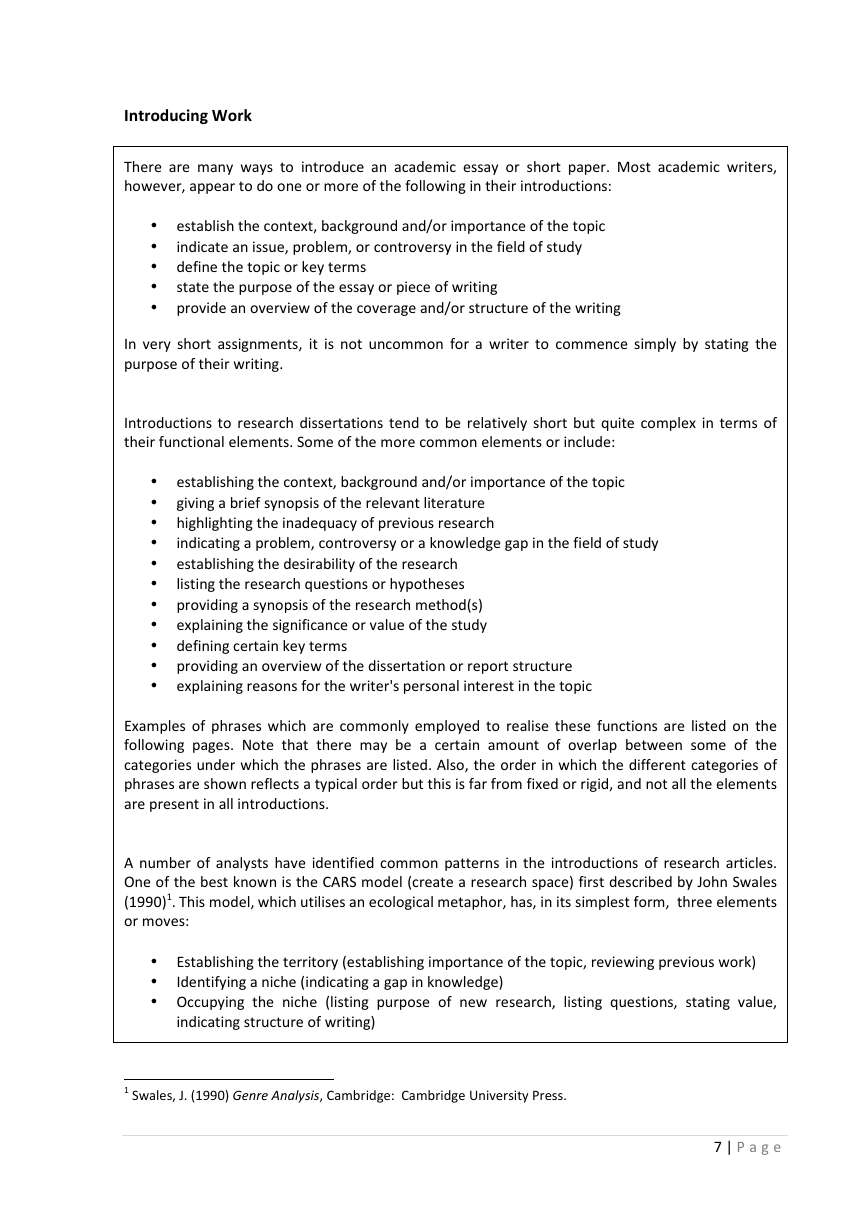








 2023年江西萍乡中考道德与法治真题及答案.doc
2023年江西萍乡中考道德与法治真题及答案.doc 2012年重庆南川中考生物真题及答案.doc
2012年重庆南川中考生物真题及答案.doc 2013年江西师范大学地理学综合及文艺理论基础考研真题.doc
2013年江西师范大学地理学综合及文艺理论基础考研真题.doc 2020年四川甘孜小升初语文真题及答案I卷.doc
2020年四川甘孜小升初语文真题及答案I卷.doc 2020年注册岩土工程师专业基础考试真题及答案.doc
2020年注册岩土工程师专业基础考试真题及答案.doc 2023-2024学年福建省厦门市九年级上学期数学月考试题及答案.doc
2023-2024学年福建省厦门市九年级上学期数学月考试题及答案.doc 2021-2022学年辽宁省沈阳市大东区九年级上学期语文期末试题及答案.doc
2021-2022学年辽宁省沈阳市大东区九年级上学期语文期末试题及答案.doc 2022-2023学年北京东城区初三第一学期物理期末试卷及答案.doc
2022-2023学年北京东城区初三第一学期物理期末试卷及答案.doc 2018上半年江西教师资格初中地理学科知识与教学能力真题及答案.doc
2018上半年江西教师资格初中地理学科知识与教学能力真题及答案.doc 2012年河北国家公务员申论考试真题及答案-省级.doc
2012年河北国家公务员申论考试真题及答案-省级.doc 2020-2021学年江苏省扬州市江都区邵樊片九年级上学期数学第一次质量检测试题及答案.doc
2020-2021学年江苏省扬州市江都区邵樊片九年级上学期数学第一次质量检测试题及答案.doc 2022下半年黑龙江教师资格证中学综合素质真题及答案.doc
2022下半年黑龙江教师资格证中学综合素质真题及答案.doc